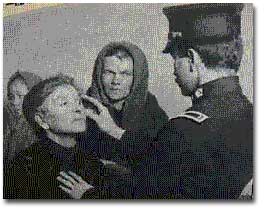| Evaluation
Individual
Grading
While cooperation
and team work are key to this project, it is not uncommon for some
group members to work to a lesser or to a greater degree than
others. To address this concern, individual grades will be
determined based on the points earned by the segment, and based on
the group's evaluation of each of its members.
The segment
producer will keep a record of the daily attendance and
activities of each  group member. After the group segment has been graded, the group
will collaboratively determine the grade of each member of the
group.
group member. After the group segment has been graded, the group
will collaboratively determine the grade of each member of the
group.
For example, if the group segment earns
a total of 20/24 possible total points, or 83%, the group will need
to decide how to fairly distribute 332 percentage points (83 project
grade X 4 members) among the members of the group. Attendance, work
ethic, and cooperation are some of the factors that a group should
use in order to determine how many points to award to each member.
If problems arise during this process that cannot be peaceably
worked out by the members of the group, they should consult the
teacher for assistance.
A sample individual grade distributions
follows:
Total Group Grade =
20/24 or 83%. With 4 group members there are now 332 total
points that can be assigned to each individual group member.
For example:
| Joe |
= |
75% |
| Sally |
= |
91% |
| Tom |
= |
96% |
| Sue |
= |
70% |
| Group Total |
= |
332 | |
Project Grading
As we
discussed in class, a high-quality documentary has a certain look
and feel to it, which we are going to try to emulate using
PowerPoint. Based on the criteria that we developed in class, please
keep the following grading rubric in mind as you collaboratively
create your segment:
|
Criteria |
Score |
| Factual
Content-The information included in the documentary is
accurate and relevant to the topic, and includes all of the
required items listed on the Documentary
Segments page. |
|
| Use of
Primary Sources-Several relevant primary sources (e.g.,
photographs, Supreme Court rulings, Federal legislation,
personal accounts, etc.) have been used to provide information
about the content contained in the documentary
segment. |
|
| Media
Use-The sounds, images, animations, and slide transitions
that are used are both relevant and purposeful. |
|
| Organization-The documentary segment is
organized in a logical manner, making it easy to understand
the information that is being presented. |
|
| Citation-The last slide of the PowerPoint
presentation contains an MLA-style
Works Consulted listing all of the resources used for this
project (e.g., textbook, review book, web pages,
etc.). |
|
| Narration/Interview(s)-Narration and/or
interview(s) are used as the primary means of transmitting
information for the documentary. The narration and/or
interview(s) are relevant and compliment the media selected
for the documentary segment. |
|
| Study
Guide-The study guide acts as an outline of the
documentary, providing students with a resource to review the
material presented. The study guide should closely follow the
presentation of the documentary. |
|
| Formatting-The segment maintains the formatting
required to create a uniform class documentary (e.g.,
background color, font size, font type, font color, etc.) and
is between 10 and 15 minutes in length. |
|
|
Total Points |
|
|
Grade |
|
Each of these criteria will be rated
according to the following point scale:
| Score |
Meaning |
| 3 |
Excellent-This
criteria has been met in every possible way, and may even
exceed expectations. |
| 2 |
Acceptable-This criteria has been mostly
addressed, however, there is room for
improvement. |
| 1 |
Sub par-Some
elements have been met, but most of the criteria fails to be
addressed. |
| 0 |
Incomplete-This criteria has not been addressed
in any meaningful way or has not been
completed. | |
